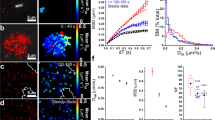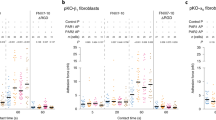Abstract
Interactions between adhesion molecules on two different cells differ from interactions between receptors and soluble ligands in that the adhesion molecule interaction (bond) is often subjected to force. It is widely assumed by cell biologists that the ‘strength’ of a bond is a simple function of the affinity of one adhesion molecule for the other, whereas biophysicists suggest that bonds have ‘mechanical properties’ that affect their strength. Mechanical properties are a function of the shape of the energy landscape related to bond formation and dissociation, whereas affinity is related only to the net energy change1,2,3,4,5,. Mechanical properties determine the amount by which thekinetics and affinity of bonds are altered by applied force. To date there has been no experimental manipulation of an adhesion molecule that has been shown to affect mechanical properties. L-selectin is an adhesion molecule that mediates lymphocyte binding to, and rolling on, high endothelial venules; these are prerequisites for the emigration of lymphocytes from the bloodstream into lymph nodes. Here we report a selective and reversible chemical modification of a mucin-like ligand that alters the mechanical properties of its bond with L-selectin. The effect of force on the rate of bond dissociation, that is, on a mechanical property, is altered, whereas there is little or no effect of the modification on the rate of bond dissociation in the absence of force. Moreover, the puzzling requirement for hydrodynamic shear flow above a threshold level for L-selectin interactions6,7,8,9, is dramatically altered.
This is a preview of subscription content, access via your institution
Access options
Subscribe to this journal
Receive 51 print issues and online access
$199.00 per year
only $3.90 per issue
Buy this article
- Purchase on Springer Link
- Instant access to full article PDF
Prices may be subject to local taxes which are calculated during checkout




Similar content being viewed by others
References
Bell, G. I. Models for the specific adhesion of cells to cells: a theoretical framework for adhesion mediated by reversible bonds between cell surface molecules. Science 200, 618–627 (1978).
Dembo, M., Torney, D. C., Saxman, K. & Hammer, D. The reaction-limited kinetics of membrane-to-surface adhesion and detachment. Proc. R. Soc. Lond. B 234, 55–83 (1988).
Leckband, D., Müller, W., Schmitt, F.-J. & Ringsdorf, H. Molecular mechanisms determining the strength of receptor-mediated intermembrane adhesion. Biophys. J. 69, 1162–1169 (1995).
Bruinsma, R. Les liaisons dangereuses: adhesion molecules do it statistically. Proc. Natl Acad. Sci. USA 94, 375–376 (1997).
Evans, E. & Ritchie, K. Dynamic strength of molecular adhesion bonds. Biophys. J. 72, 1541–1555 (1997).
Finger, E. B. et al. Adhesion through L-selectin requires a threshold hydrodynamic shear. Nature 379, 266–269 (1996).
Alon, R., Fuhlbrigge, R. C., Finger, E. B. & Springer, T. A. Interactions through L-selectin between leukocytes and adherent leukocytes nucleate rolling adhesions on selectins and VCAM-1 in shear flow. J. Cell Biol. 135, 849–865 (1996).
Lawrence, M. B., Kansas, G. S., Kunkel, E. J. & Ley, K. Threshold levels of fluid shear promote leukocyte adhesion through selectins (CD62L,P.E.). J. Cell Biol. 136, 717–727 (1997).
Taylor, A. D., Neelamegham, S., Hellums, J. D., Smith, C. W. & Simon, S. I. Molecular dynamics of the transition from L-selectin-to β2-integrin-dependent neutrophil adhesion under defined hydrodynamic shear. Biophys. J. 71, 3488–3500 (1996).
Lasky, L. A. & Rosen, S. D. in Inflammation: Basic Principles and Clinical Correlates Vol. 2(eds Gallin, J. I., Goldsten, I. J. & Snyderman, R.) 407–439 (Raven, New York, 1992).
Kansas, G. S. Selectins and their ligands: current concepts and controversies. Blood 88, 3259–3287 (1996).
Springer, T. A. Traffic signals on endothelium for lymphocyte recirculation and leukocyte emigration. Annu. Rev. Physiol. 57, 827–872 (1995).
Alon, R., Chen, S., Puri, K. D., Finger, E. B. & Springer, T. A. The kinetics of L-selectin tethers and the mechanics of selectin-mediated rolling. J. Cell Biol. 138, 1169–1180 (1997).
Alon, R., Hammer, D. A. & Springer, T. A. Lifetime of the P-selectin: carbohydrate bond and its response to tensile force in hydrodynamic flow. Nature 374, 539 (1995).
Norgard, K. E. et al. Enhanced interaction of L-selectin with the high endothelial venule ligand via selectively oxidized sialic acids. Proc. Natl Acad. Sci. USA 90, 1068–1072 (1993).
Puri, K. D. & Springer, T. A. ASchiff base with mildly oxidized carbohydrate ligands stabilizes L-selectin and not P-selectin or E-selectin rolling adhesions in shear flow. J. Biol. Chem. 271, 5404–5413 (1996).
Baumhueter, S. et al. Binding of L-selectin to the vascular sialomucin, CD34. Science 262, 436–438 (1993).
Puri, K. D., Finger, E. B., Gaudernack, G. & Springer, T. A. Sialomucin CD34 is the major L-selectin ligand in human tonsil high endothelial venules. J. Cell Biol. 131, 261–270 (1995).
Nicholson, M. W., Barclay, A. N., Singer, M. S., Rosen, S. D. & van der Merwe, P. A. Affinity and kinetic analysis of L-selectin (CD62L) binding to GlyCAM-1. J. Biol. Chem. 273, 763–770 (1998).
Pierres, A., Benoliel, A.-M. & Bongrand, P. Experimental study of the rate of bond formation between individual receptor-coated spheres and ligand-bearing surfaces. J. Phys. III France 6, 807–824 (1996).
Kyte, J. Structure in Protein Chemistry (Garland, New York, 1995).
Dembo, M. in Some Mathematical Problems in Biology: Lectures on Mathematics in the Life Sciences Vol. 25(eds Goldstein, B. & Wofsy, C.) 1–27 (American Mathematical Society, Providence, 1994).
Puri, K. D., Finger, E. B. & Springer, T. A. The faster kinetics of L-selectin than of E-selectin and P-selectin rolling at comparable binding strength. J. Immunol. 158, 405–413 (1997).
Chen, S., Alon, R., Fuhlbrigge, R. C. & Springer, T. A. Rolling and transient tethering of leukocytes on antibodies reveal specializations of selectins. Proc. Natl Acad. Sci. USA 94, 3172–3177 (1997).
Acknowledgements
We thank T. K. Kishimoto, E. Butcher and G. Gaudernack for reagents.
Author information
Authors and Affiliations
Rights and permissions
About this article
Cite this article
Puri, K., Chen, S. & Springer, T. Modifying the mechanical property and shear threshold of L-selectin adhesion independently of equilibrium properties. Nature 392, 930–933 (1998). https://doi.org/10.1038/31954
Received:
Accepted:
Issue Date:
DOI: https://doi.org/10.1038/31954
This article is cited by
-
Dynamic biochemical tissue analysis detects functional selectin ligands on human cancer tissues
Scientific Reports (2019)
-
Metabolic Oligosaccharide Engineering: Implications for Selectin-Mediated Adhesion and Leukocyte Extravasation
Annals of Biomedical Engineering (2012)
-
Targeted delivery of therapeutics to endothelium
Cell and Tissue Research (2009)
-
Polysaccharide elasticity governed by chair–boat transitions of the glucopyranose ring
Nature (1998)
Comments
By submitting a comment you agree to abide by our Terms and Community Guidelines. If you find something abusive or that does not comply with our terms or guidelines please flag it as inappropriate.



